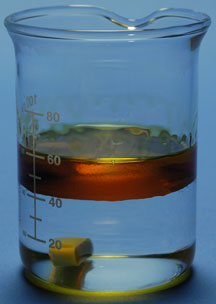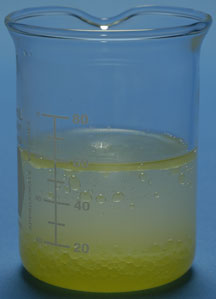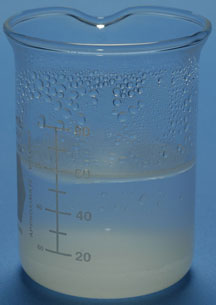

Solubility Doesn't Matter—Organic Reactions in Aqueous Suspensions
By Jason Socrates Bardi
Organic chemists usually rely upon organic solvents to perform their reactions—often large amounts of solvents. Walk through the storage rooms of most modern organic chemistry labs and you will see the solvents lining the shelves in gallon jugs and big metal canisters.
Conventional wisdom holds that using solvents is the best way of reacting compounds in synthetic chemistry, because the different compounds can be dissolved in the solvents before being mixed. This generally increases the speed and efficiency of a reaction over the mixing of solids. Solvents are a convenient tool for other reasons as well, such as the fact that they can help to control reactions by dissipating the heat generated in many reactions. Advantages like these make solvents something of a way of life in chemistry laboratories.
Even more convenient would be to use water as a solvent. After all, water is safe, cheap, and laboratories are generally equipped with an unlimited supply of it. Water is more environmentally friendly than perhaps any other molecule on earth, and it has a number of other properties that could make it a great solvent. It has a high heat capacity, for instance, which means that as a solvent it can also act as a heat sink for highly exothermic reactions. Why not use water, then?
In fact, says Research Associate Sridhar Narayan in the Department of Chemistry at The Scripps Research Institute, "Water is rarely used as a solvent in organic chemistry." When it is used, he adds, it is usually in combination with other water-miscible solvents."
Water has a number of major disadvantages. Many of the reactions that modern organic chemists use rely on powerful acids and bases that will themselves react with the water. Carrying out reactions in water limits the acids and bases that can be used. Moreover, most organic compounds don't dissolve very much in water.
However, Narayan is part of a team of chemists at Scripps Research led by Professor K. Barry Sharpless and including Associate Professor M.G. Finn and Assistant Professor Valery Fokin that published a paper in a recent issue of the journal Angewandte Chemie suggesting that in certain cases solubility doesn't matter.
In the article, Sharpless, Narayan, Finn, Fokin, and their colleagues show that there are cases where it may be advantageous to use water to react organic compounds after all—although not exactly as a solvent but by floating the reactants on water.
They found that when they added two insoluble reactants to water alone and continuously stirred the suspension, some reactions proceed rapidly when compared to the same reaction taking place in solution.
Click Chemistry at the Interface
Sharpless, who is the W.M. Keck Professor of Chemistry and a member of The Skaggs Institute for Chemical Biology at Scripps Research, has been recognized numerous times over the years for his pioneering work in organic chemistry. In 2001, he was awarded the Nobel Prize in Chemistry, along with William S. Knowles and Ryoji Noyori for "the development of catalytic asymmetric synthesis."
In the last few years, Sharpless has been working on a new type of chemistry, known as click chemistry, which relies on using a few highly efficient reactions to do organic synthesis. Click chemistry relies on using stable building blocks like azides and alkynes that react with each other in highly efficient, energetic, and irreversible spring-loaded reactions.
Many of the reactions that Sharpless and his colleagues have been carrying out in the last few years have been done in water—or to be more exact, "on" water—by mixing the insoluble suspensions in the water. The water in this case was used not as a solvent, since the reactants were not actually soluble in water. It was there to mediate the heat, since click chemistry employs reactions that are quite energetic.
In the course of this work, Sharpless and his colleagues found something unique about some of the reactions they were carrying out. Despite the lack of organic solvents, a lot of the chemistry they were doing in water seemed to proceed just fine. In fact, they discovered that some reactions were considerably accelerated by mixing the insoluble reactants in water.
Hoping to discover whether these examples were isolated cases or in fact a general trend, Sharpless, Narayan, and their colleagues looked at many different reactions and found different levels of acceleration for different reactions.
"It varies a lot," says Narayan, "but in many cases, you see significant acceleration of the reaction in suspension."
One reaction they performed was the addition of quadricyclane with dimethyl azodicarboxylate. In the past, this reaction was typically carried to completion by dissolving the reactants in the organic solvents benzene or toluene, heating up the mixture to 80° C, and stirring for 24 hours. The reaction could also be done "neat" by mixing quadricyclane with dimethyl azodicarboxylate without the solvent, but this would take nearly two days to complete.
But Sharpless, Narayan, and their colleagues found that by mixing neat (undissolved) quadricyclane and dimethyl azodicarboxylate on water, the reaction was accelerated more than 100-fold and was finished in five or ten minutes.
There is some precedent for this. Many industrial processes mix large quantities of water-insoluble chemicals in water. Moreover, several years ago, Professor Ronald Breslow of Columbia University found that putting tiny amounts of water-insoluble reactants in water speeded up the rates of Diels–Alder reactions.
The aforementioned industrial processes are not designed to use water to achieve acceleration of the reaction so much as they rely on its high heat capacity, which can help contain the heat of the reaction. Water is used in these reactions not so much a solvent as it is a liquid vessel in which the reaction takes place.
Also, Breslow and his associates did their work with much smaller amounts of reactants—they were not doing reactions on a scale anywhere near that employed by the Scripps Research team. This is because they were mainly interested in studying the phenomenon known as the hydrophobic effect but not in preparative chemistry.
As such, the results Sharpless, Narayan, and their colleagues obtained are essentially the first to raise some interesting new questions about the use of water in synthetic chemistry.
Traditionally, chemists have known that solvation of reactants in solution helps a reaction not only because the molecules are mixed more efficiently, but also because the solvent energetically stabilizes some of the reaction intermediaries so that it can proceed faster. How does water accelerate a reaction if it can do neither of these things?
One possibility is that the insoluble solids may be ever-so-slightly soluble in water. Mixing them in the water creates a dynamic equilibrium with a small amount of the reactants becoming solvated, reacting with each other, falling out of solution as a product, and allowing more reactants to enter into solution and react.
However, the reaction rates that the Scripps Research team observed are much faster than one would expect with this sort of mechanism.
Instead, Sharpless, Narayan, and their colleagues propose that the speedy reactions are due to some surface phenomenon. Though they don't know precisely what's happening at the interface of the water with the insoluble reactants, they suspect that hydrophobic and other forces are being exerted at the water–organic compound interface that may be responsible. These hydrophobic forces are one of the fundamental interactions in nature, after all, driving the folding of proteins in solution for example.
Explaining how these hydrophobic forces might work, Narayan says that it would be like going to a cocktail party in another country. You naturally gravitate towards the individuals or groups in the room who speak your language.
Meanwhile, in this country, Sharpless, Narayan, and their colleagues are continuing to explore the phenomenon.
The article, "On Water": Unique Reactivity of Organic Compounds in Aqueous Suspension" by Sridhar Narayan, John Muldoon, M. G. Finn, Valery V. Fokin, Hartmuth C. Kolb, and K. Barry Sharpless appears in the May 20, 2005 issue of the journal Angewandte Chemie (v. 44, p. 3137). The article can be found online at: http://dx.doi.org/10.1002/anie.200590069\.
Send comments to: jasonb@scripps.edu
The Utility and Ease of a Typical 'On Water' Reaction:

The progression of the "ene" reaction between diethyl azodicarboxylate (orange) and ß-pinene (colorless) is shown here before stirring has started. The reactants are mixed together and floating on water.

This is how the reaction looks midway through. As the diethyl azodicarboxylate is consumed, the color fades to yellow.

Here the diethyl azodicarboxylate and ß-pinene reaction is complete, and the product, which is also colorless, has settled to the bottom. This product can then be obtained simply by pouring the water off.
